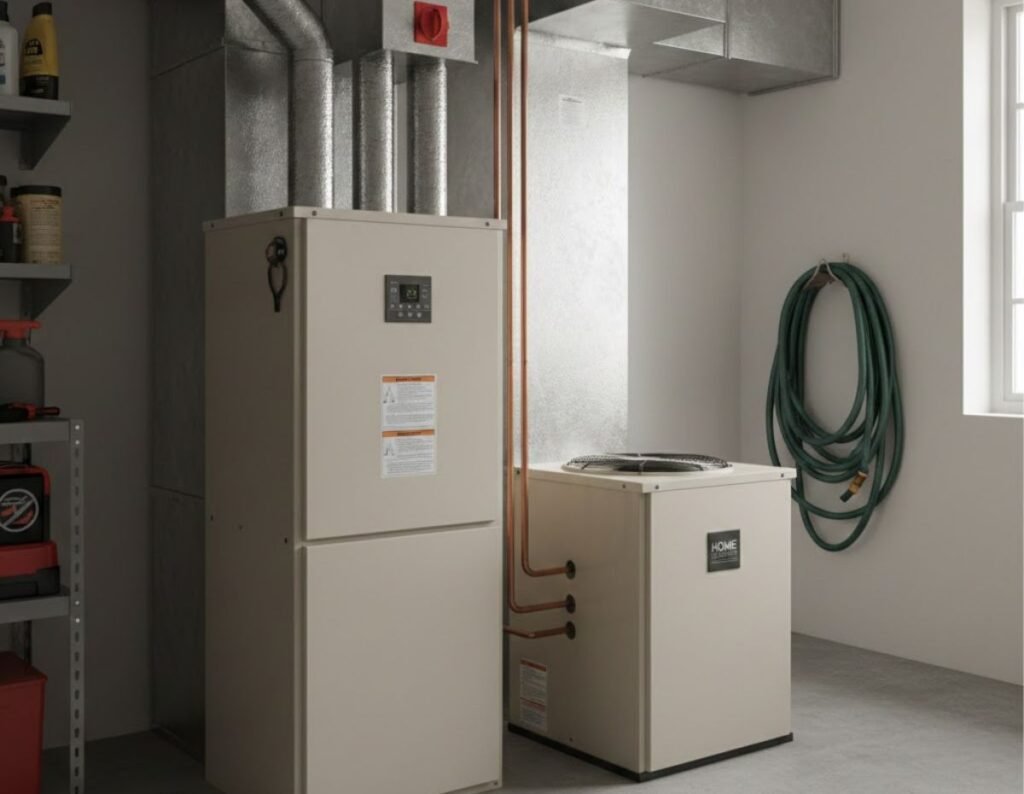Winter’s knocking at your door, and your old furnace is wheezing like it’s on its last breath? Don’t freeze this season! Upgrading to a new furnace heater in the USA could slash your energy bills by up to 40%, boost home comfort, and even add thousands to your property value. With over 55 million American homes relying on furnaces for heat, 2025 is the perfect time to modernize. Stricter EPA rules, smart tech integrations, and massive rebates make now ideal for furnace replacement.
Whether you’re in chilly Minnesota or milder Texas, this eye-catching guide breaks it all down. We’ll cover types of furnace heaters, costs, best brands, installation, and more. Plus, a handy comparison table to pit gas vs. electric head-to-head. Ready to stay toasty without breaking the bank? Let’s crank up the heat!

What Is a Furnace Heater and Why Go for a New One?
A furnace heater (or simply furnace) is your home’s powerhouse for central heating. It warms air using gas, oil, or electricity, then pushes it through ducts to vents throughout your house. Unlike boilers that heat water, furnaces deliver forced-air heat quick, adjustable, and perfect for USA homes with ductwork.
Why swap your old clunker for a new furnace in 2025?
- Massive Energy Savings: Old units guzzle 30% more energy; new ones hit 98% AFUE (Annual Fuel Utilization Efficiency).
- Skyrocketing Bills? Fixed!: Save $500-1,200 yearly on heating, per Energy.gov.
- Eco-Warrior Status: Cut emissions by 50% with high-efficiency models, qualifying for federal tax credits up to $2,000.
- Smart Home Ready: Integrate with Alexa, Google Home, or Wi-Fi thermostats for voice-controlled warmth.
- Health Boost: Advanced filters trap allergens, dust, and pollutants—no more sneezy winters.
- Longevity & Reliability: Expect 15-30 years of trouble-free use with warranties up to 20 years.
- Home Value Spike: Realtors say a new furnace can add 5-7% to your sale price.
Signs it’s time: Uneven heating, frequent breakdowns, rising bills, or if it’s 10+ years old. With natural disasters like polar vortexes hitting harder, a reliable furnace heater is non-negotiable.
READ MORE: Heat Pumps
Types of Furnace Heaters Popular in the USA
The USA’s diverse climates mean one-size-fits-all? Nah! Here’s the lineup of furnace types dominating the market:
Gas Furnaces
- Most Common: Powers 60% of USA homes.
- Single-Stage: Basic on/off; affordable but less efficient.
- Two-Stage: Runs low/high for better comfort.
- Modulating: Adjusts precisely like a dimmer switch—top efficiency.
Pros: Cheap to run ($1.50-2.50/MMBtu gas); heats fast.
Cons: Needs venting; not for off-grid spots.
Electric Furnaces
- Plug-and-Play: No fuel lines; ideal for all-electric homes.
- Heat Pump Hybrids: Pair with AC for year-round savings.
Pros: Silent, no emissions; easy install.
Cons: High electric costs ($0.10-0.20/kWh); pricier to operate in cold states.
Oil Furnaces
- Rural Royalty: Big in Northeast without gas access.
- High-Output Models: For massive homes or extreme cold.
Pros: Intense heat; stores fuel on-site.
Cons: Noisy; oil prices volatile ($3-5/gallon).
Propane Furnaces
- Gas Alternative: For rural or gas-free areas.
Pros: Cleaner than oil; portable tanks.
Cons: Conversion costs if switching from gas.
Hot Tip: In 2025, variable-speed blower furnaces rule for zoned heating—perfect for multi-story homes.
Benefits of Upgrading to a New Furnace Heater
Ditch the drafts and dive into these game-changing perks:
- Uniform Comfort: Even heat everywhere—no cold spots.
- Quiet Operation: Variable-speed fans whisper, not roar.
- Air Quality Upgrade: HEPA filters + UV lights kill germs.
- Zoning Magic: Heat only occupied rooms, saving 20-30%.
- Rebates Galore: IRA incentives + state programs (e.g., California’s $8,000 rebates).
- Safety First: Auto shut-off, CO detectors built-in.
- Future-Proof: Ready for renewable integrations like solar.
Real Talk: One homeowner in Chicago swapped a 1980s gas furnace for a modulating model and saw bills drop from $450 to $280/month!
How to Choose the Perfect Furnace for Your Home
Don’t guess—size it right! A pro’s Manual J heat load calculation ensures efficiency.
Key Decision Factors:
- Home Size: 1,500 sq ft? 60,000 BTU. 3,000 sq ft? 120,000 BTU.
- Climate Zone: High-efficiency for Alaska; standard for Florida.
- Fuel Source: Gas cheapest in Midwest; electric in sunny Southwest.
- Efficiency: AFUE 95%+ for max savings.
- Budget: $3,000-$7,000 for unit; add install.
- Features: Wi-Fi, variable-speed, ECM motors.
- Noise Level: Under 60 dB for peace.
Pro Tip: Use ENERGY STAR’s selector tool. Get 3 quotes from NATE-certified installers.
READ MORE: Underfloor Heating
Furnace Heater Costs in the USA: Breakdown & Savings Hacks
Budget busters? Not here! Average furnace replacement cost: $5,000-$10,000, including install. Varies by type and region.
Detailed Cost Table:
| Component | Gas Furnace | Electric Furnace | Oil Furnace |
| Unit Price | $2,500-$5,000 | $1,500-$3,500 | $3,000-$6,000 |
| Installation | $1,500-$3,000 | $1,000-$2,000 | $2,000-$4,000 |
| Ductwork Mods | $500-$2,000 | $300-$1,000 | $800-$2,500 |
| Total Avg. | $5,500-$10,000 | $3,000-$6,500 | $6,000-$12,000 |
| Annual Operating Cost | $800-$1,200 | $1,200-$2,000 | $1,000-$1,800 |
Regional Breakdown:
- Northeast: $6,000-$12,000 (high labor).
- South: $4,000-$8,000 (milder needs).
- West Coast: $5,500-$10,500 (seismic upgrades).
Save Big:
- Off-Season Deals: Summer installs = 20% off.
- Rebates: Up to $2,000 federal + local (e.g., NY’s $1,500).
- Financing: 0% APR from brands like Carrier.
- DIY Prep: Clear attic space yourself.
Energy Efficiency & USA Regulations for Furnaces
Uncle Sam Says: Minimum AFUE 78% for gas, 80% for oil (DOE rules). Aim for 96%+ to qualify for ENERGY STAR.
Efficiency Boosters:
- Sealed Combustion: Safer, efficient venting.
- Smart Thermostats: Ecobee saves 23% energy.
- Insulation Pairing: Seal ducts to prevent 20% loss.
- Low-NOx Burners: Meets CA’s strict emissions.
2025 Trends: Push for all-electric by 2030 in states like NY. Heat pumps are rising, but gas furnaces still king for cold snaps.
Top Furnace Brands in the USA for 2025
Winners Circle—based on Consumer Reports & reliability:
- Carrier: Infinity series—top efficiency, quietest.
- Trane: American Standard sibling; 20-year warranties.
- Lennox: SLP98—smart, modulating beasts.
- Goodman: Budget champ; solid for value.
- Bryant: Carrier’s affordable twin.
- Amana: QuietComfort—great for allergies.
- Payne: Entry-level with pro features.
Brand Comparison Snippet: Lennox edges Trane in efficiency; Goodman wins on price.
READ MORE: How Does an Electric Water Heater Work?
Furnace Installation Process: Step-by-Step
Smooth as Silk with pros—takes 1-4 days.
- Site Survey: Duct check, sizing.
- Demo Old Unit: Safe removal.
- New Install:
- Mount furnace.
- Connect gas/electric.
- Wire controls.
- Test airflow.
- Commissioning: Balance system, calibrate.
- Cleanup & Training: You’re set!
Costly Mistakes to Avoid: Skipping duct cleaning ($300 extra later).
Maintenance for Long-Lasting Furnace Heaters
Prevent Breakdowns with this routine:
Annual:
- Pro tune-up ($150-$300).
- Clean coils, check belts.
Monthly:
- Replace filters ($10 each).
- Vacuum vents.
- Monitor thermostat.
Seasonal:
- Winterize: Lubricate fan.
- Check for CO leaks.
Lifespan Hack: Soft water = less scale buildup.
Furnace Types Comparison Table
| Feature | Gas Furnace | Electric Furnace | Oil Furnace |
| Efficiency (AFUE) | 80-98% | 95-100% | 80-90% |
| Upfront Cost | Medium ($3K-$6K) | Low ($2K-$4K) | High ($4K-$7K) |
| Operating Cost | Low | High | Medium-High |
| Best For | Cold climates, gas areas | Mild areas, all-electric | Rural, no gas |
| Pros | Fast heat, cheap fuel | Easy install, clean | Powerful output |
| Cons | Venting needed, emissions | Electricity-dependent | Messy fuel, storage |
| Lifespan | 15-20 years | 20-30 years | 15-25 years |
| Eco-Friendliness | Medium (low-NOx options) | High (no emissions) | Low ( |
Comparison of Furnaces and Other Home Heating Systems
| Heating System | How It Works | Pros | Cons | Efficiency (AFUE Rating) | Upfront Cost | Suitability |
| Furnace | Heats air via gas, oil, propane, or electricity and distributes it through ducts using a blower fan. | Quick heating; lower initial costs; can integrate with central AC. | Can create drafts and uneven heating; noisier due to blower; potential for dust circulation. | Up to 98.5% for high-efficiency models. | $2,500–$6,000 (installation). | Whole-home heating in larger spaces, especially cold climates with ductwork. |
| Boiler | Heats water or steam and circulates it through pipes to radiators, baseboards, or underfloor systems. | Even, consistent heat without drafts; quieter operation; less dust; durable (lasts 20–30 years). | Slower to heat up; higher upfront costs; risk of leaks or frozen pipes. | Up to 98.5%, often slightly higher than furnaces due to radiant heat. | $4,000–$10,000 (installation). | Homes without ducts, radiant floor heating, or in very cold areas. |
| Heat Pump | Transfers heat from outside air (or ground) to inside, using electricity; reverses for cooling. | Provides both heating and cooling; highly energy-efficient in mild climates; lower operating costs. | Less effective in extreme cold (may need backup); higher upfront costs. | 300–400% (HSPF rating, not AFUE); exceeds 100% since it moves heat. | $4,000–$8,000 (air-source). | Mild to moderate climates; all-electric homes; dual-purpose systems. |
| Electric Heater (e.g., Baseboard or Space) | Uses electric resistance coils to generate heat directly in the room or zone. | Easy installation; zoned heating control; no fuel storage; clean (no emissions at point of use. | Higher operating costs; less efficient for whole-home; can dry out air. | Nearly 100% at point of use, but electricity generation losses reduce overall efficiency. | $200–$1,500 per unit (portable or baseboard). | Small spaces, supplemental heating, or areas without gas access. |
Note: Costs and efficiencies can vary by model, fuel source, and location. For personalized advice, consult a local HVAC professional. If you’d like to expand on a specific type or add more details, let me know!
FAQs About Furnace Heaters
- How long does a furnace last?
15-20 years on average, up to 30 with maintenance. Gas models wear faster than electric.
- Gas vs electric furnace: Which is better?
Gas for cold USA regions (cheaper to run); electric for mild climates or green homes. Hybrids win overall.
- How much does it cost to replace a furnace?
$3,000-$10,000 total, with gas at $5,000 avg. Includes install; rebates cut 20%.
- What are signs your furnace needs replacing?
Strange noises, short cycling, poor airflow, high bills, or age 15+ years.
- What size furnace do I need for my house?
40-60 BTU per sq ft. E.g., 2,000 sq ft home: 80,000-120,000 BTU. Get a pro calc!
Wrap-Up
Your dream of cozy, efficient heating starts now! A new furnace heater in the USA isn’t just an upgrade—it’s a smart investment saving money, energy, and the planet. From gas powerhouses to electric wonders, pick your winner with our guide. Grab quotes, snag rebates, and wave goodbye to chilly nights.
Procrastinating? Winter waits for no one. Contact a local HVAC hero today—your warmer, happier home is just an install away!

